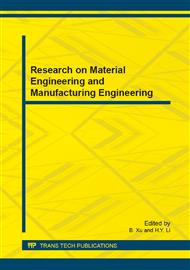p.95
p.101
p.105
p.110
p.114
p.119
p.127
p.134
p.141
Identification of the Dynamic Properties of Mechanical Joints
Abstract:
The frequency response functions (FRFs) are frequently used to identify dynamic properties of the mechanical joints. However, the ill-posed problems of the system are caused by the contamination of measurement noise even if it is processed by reduction technique. In order to solve this problem, put the noised FRFs into identification equations to theoretical derivation, explained the degree of influence on the identified results by noised FRFs in theory. In order to make the identified results represent real properties of the joints, an improved FRFs method was developed based on subtraction term frequency selection, in which the measured data were processed could get high degree of anti-noise frequency before parameters identification. This method avoids the occurrence of ill-posed problems. The results of simulation show that the proposed method can solve the ill-posed problems, thus significantly improve the accuracy of identification.
Info:
Periodical:
Pages:
114-118
Citation:
Online since:
November 2013
Authors:
Price:
Сopyright:
© 2014 Trans Tech Publications Ltd. All Rights Reserved
Share:
Citation:


